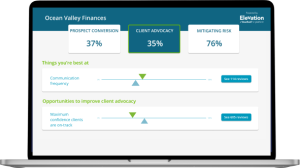As financial advisers prepare for the implementation of Consumer Duty, one of the most significant challenges they face is demonstrating and delivering fair value to clients.
We talk to Rachel MacRae, Compliance Consultant from B-Compliant, to find out how advisers can use their work on the other three outcomes to help articulate fair value.
Data strategy
The key to demonstrating fair value is having good data. Data makes assessing fair value much easier, as it provides some defined metrics to work from.
Rachel MacRae, Compliance Consultant from B-Compliant, is clear that evidencing fair value is all about data. “The data that firms need to use is probably going to come out of the other three outcomes” Rachel suggests. “There’s no point doing price and value until you know that you’ve designed products and services to meet [the client’s] needs. It’s the same with understanding. Once you’ve got those controls in place, that is what’s going to feed into your value assessment”.
Elevation data corroborates this. When reviewing clients’ ‘value for money’ ratings, firms with the highest scores for Products and Services, Consumer Support and Consumer Understanding significantly outperform those with the lowest scores.
Going “old school”
Rachel also suggests that advisers would benefit from going “old school” on their assessments by thinking about a product or service’s features and benefits. As a reminder, a feature is something the product or service does. A benefit is where that feature is of genuine use to the client.
“You might have an all bells and whistles service proposition, but if your clients aren’t using any of those features, it’s very difficult to evidence that they’re a benefit,” says Rachel. “If they’re not using [the service] that way, it’s very difficult to evidence fair value”
Pricing
As well as assessing fair value, firms will have to evidence how they’ve arrived at their conclusion.
Rachel’s view is that the FCA knows that firms have to make a profit, but it’s important for advisers to be clear on how they have come up with their fees. “Is [your fee] something you’ve just picked out of thin air?” asks Rachel. “Or have you sat and thought about the commerciality behind the fee itself?” Advisers should have their methodology, and supporting data, documented to make any future conversations with the FCA a little easier.
How can the other outcomes help?
Each of the other three outcomes will provide you with valuable data. Here’s some data you could use to assist with your value assessment:
Products and Services
Service usage: track which of your firm’s services are most popular among clients and which aren’t used, and you’ll find areas where you may need to adjust your offerings to better align with client needs and improve perceived value.
Cost of service delivery: analyse the cost structure of your service offerings, including the time and resources required to deliver each service. Comparing these costs to the fees you charge can help you evaluate whether your pricing reflects the value delivered to clients.
Performance metrics: establish key performance indicators (KPIs) for your service offerings. Regularly monitor and evaluate these KPIs to ensure that your services are delivering the desired outcomes for your clients and providing value.
Consumer Support
Client satisfaction: regularly survey your clients to gauge their satisfaction with the support they receive from your firm. By tracking client satisfaction levels over time, you can identify areas that need improvement to enhance the overall value perceived by your clients.
Support channel usage: review which support channels clients use (such as phone, post, email, or live chat) to understand which methods your clients prefer. This can help you allocate resources more effectively and tailor your support services to better align with client preferences.
Support training and development: Assess the training and development programs you provide for your support staff. Ensuring that they are well-equipped with the necessary knowledge and skills to deliver excellent client support can improve the overall value of your firm’s services.
Consumer Understanding
- Clarity of communication: regularly gather feedback from clients on the clarity and effectiveness of your communications. This may include written materials, such as reports and newsletters, as well as oral communication during meetings or phone calls. By ensuring that clients understand the information you provide, you can enhance their perception of the value your firm delivers.
- Client engagement: measure your clients’ engagement with educational resources, seminars, webinars, and workshops provided by your firm. High levels of engagement may indicate that clients are gaining valuable insights from these resources, which can contribute to their overall perception of your firm’s value.
- Personalised communication: evaluate the extent to which your firm’s communications are tailored to individual clients’ needs and preferences. Personalised communication can help clients feel better understood, leading to a stronger perception of value.
The key to demonstrating fair value is having good data and a well thought out approach to pricing. Each of the other three outcomes provide valuable data, which will help with your value assessment. It therefore makes sense to tackle price and value last.
Returning to “features and benefits” will help frame what is of real value to your clients and could inform your pricing strategy.
Don’t forget that value is a very personal thing, so don’t underestimate the importance of client feedback to find out if they feel like they’re getting value for money. Rachel agrees saying that “Client feedback is going to be a really, really, useful tool [for value assessments]”.
Whether you decide to change your pricing or services, or find data to back them up, as Consumer Duty approaches the real question is, do you have the data to support your decision?




